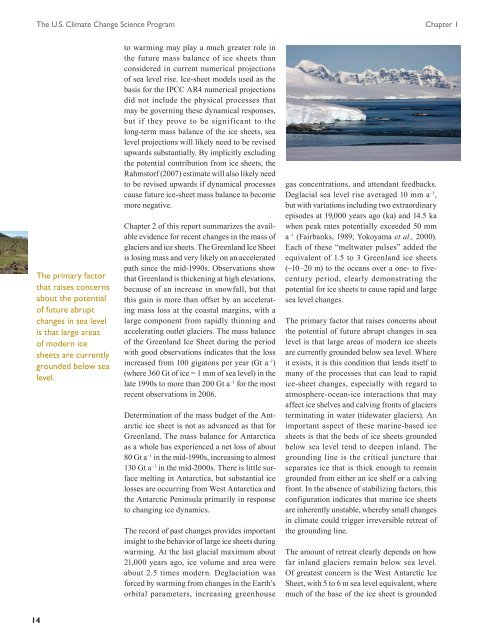Book 2.indb - US Climate Change Science Program
Book 2.indb - US Climate Change Science Program
Book 2.indb - US Climate Change Science Program
- No tags were found...
You also want an ePaper? Increase the reach of your titles
YUMPU automatically turns print PDFs into web optimized ePapers that Google loves.
The U.S. <strong>Climate</strong> <strong>Change</strong> <strong>Science</strong> <strong>Program</strong> Chapter 1The primary factorthat raises concernsabout the potentialof future abruptchanges in sea levelis that large areasof modern icesheets are currentlygrounded below sealevel.to warming may play a much greater role inthe future mass balance of ice sheets thanconsidered in current numerical projectionsof sea level rise. Ice-sheet models used as thebasis for the IPCC AR4 numerical projectionsdid not include the physical processes thatmay be governing these dynamical responses,but if they prove to be significant to thelong-term mass balance of the ice sheets, sealevel projections will likely need to be revisedupwards substantially. By implicitly excludingthe potential contribution from ice sheets, theRahmstorf (2007) estimate will also likely needto be revised upwards if dynamical processescause future ice-sheet mass balance to becomemore negative.Chapter 2 of this report summarizes the availableevidence for recent changes in the mass ofglaciers and ice sheets. The Greenland Ice Sheetis losing mass and very likely on an acceleratedpath since the mid-1990s. Observations showthat Greenland is thickening at high elevations,because of an increase in snowfall, but thatthis gain is more than offset by an acceleratingmass loss at the coastal margins, with alarge component from rapidly thinning andaccelerating outlet glaciers. The mass balanceof the Greenland Ice Sheet during the periodwith good observations indicates that the lossincreased from 100 gigatons per year (Gt a –1 )(where 360 Gt of ice = 1 mm of sea level) in thelate 1990s to more than 200 Gt a –1 for the mostrecent observations in 2006.Determination of the mass budget of the Antarcticice sheet is not as advanced as that forGreenland. The mass balance for Antarcticaas a whole has experienced a net loss of about80 Gt a –1 in the mid-1990s, increasing to almost130 Gt a –1 in the mid-2000s. There is little surfacemelting in Antarctica, but substantial icelosses are occurring from West Antarctica andthe Antarctic Peninsula primarily in responseto changing ice dynamics.The record of past changes provides importantinsight to the behavior of large ice sheets duringwarming. At the last glacial maximum about21,000 years ago, ice volume and area wereabout 2.5 times modern. Deglaciation wasforced by warming from changes in the Earth’sorbital parameters, increasing greenhousegas concentrations, and attendant feedbacks.Deglacial sea level rise averaged 10 mm a –1 ,but with variations including two extraordinaryepisodes at 19,000 years ago (ka) and 14.5 kawhen peak rates potentially exceeded 50 mma –1 (Fairbanks, 1989; Yokoyama et al., 2000).Each of these “meltwater pulses” added theequivalent of 1.5 to 3 Greenland ice sheets(~10–20 m) to the oceans over a one- to fivecenturyperiod, clearly demonstrating thepotential for ice sheets to cause rapid and largesea level changes.The primary factor that raises concerns aboutthe potential of future abrupt changes in sealevel is that large areas of modern ice sheetsare currently grounded below sea level. Whereit exists, it is this condition that lends itself tomany of the processes that can lead to rapidice-sheet changes, especially with regard toatmosphere-ocean-ice interactions that mayaffect ice shelves and calving fronts of glaciersterminating in water (tidewater glaciers). Animportant aspect of these marine-based icesheets is that the beds of ice sheets groundedbelow sea level tend to deepen inland. Thegrounding line is the critical juncture thatseparates ice that is thick enough to remaingrounded from either an ice shelf or a calvingfront. In the absence of stabilizing factors, thisconfiguration indicates that marine ice sheetsare inherently unstable, whereby small changesin climate could trigger irreversible retreat ofthe grounding line.The amount of retreat clearly depends on howfar inland glaciers remain below sea level.Of greatest concern is the West Antarctic IceSheet, with 5 to 6 m sea level equivalent, wheremuch of the base of the ice sheet is grounded14






